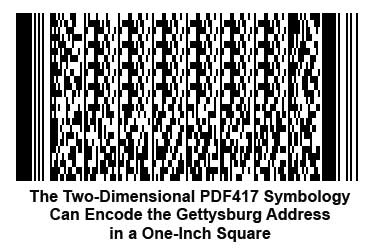SCDigest
Editorial Staff
| SCDigest Says: |
 It also seems clear that rapid advances in overall corporate networking and the use of the Internet to connect trading partners reduced the expected need for “portable data bases” disconnected from corporate databases. It also seems clear that rapid advances in overall corporate networking and the use of the Internet to connect trading partners reduced the expected need for “portable data bases” disconnected from corporate databases. 
What do you say? Send
us your comments here |
In the early 1990’s, Symbol Technologies, with much fanfare, introduced PDF417, a two-dimensional bar code symbology capable of encoding a lot of data in a little amount of space.
Approximately 15 years later, has PDF417 come close to reaching the potential Symbol (recently acquired my Motorola) and other industry experts predicted?
The results are mixed. PDF417 certainly has a place in today’s Automatic Identification landscape, but does not seem to have fully lived up to its promise. In retrospect, the growth of the Internet and network connectivity across the enterprise probably reduced the need for “portable data files.” More recently, RFID has emerged as a strong alternative when an item or asset needs to be tracked with more than an identification number.
PDF417 Overview
The bar codes most familiar to supply chain and logistics professionals are considered “linear” bar codes – a single line of bars and spaces that in general encode a set of numbers or number/letter combinations. Common examples include the UPC bar code used at retail point-of-sale, or the 128 symbology used in many supply chain applications. The capacity of a linear symbology to record data is limited; linear codes are almost always used not for their information directly, but as a key to retrieve information from a database, such as the item and price in a retail setting from a UPC bar code scan.
So called “two-dimensional” bar codes use more than a single line of bars and spaces, and therefore can hold more information per bar code than linear symbols. PDF417 (see graphic nearby) was touted as a breakthrough at its release because it could encode more information than existing two-dimensional bar codes, and because it included security features that enabled encryption of the encoded data and error correction features for bad scans or damaged labels.
As an example of the symbol’s capacity, Symbol Technologies for many years showed Abraham Lincoln’s entire Gettysburg address encoded in a one-inch by one-inch PDF417 bar code. Given this huge data capacity (multiple symbols could actually be “stitched” together, to provide almost limitless capacity), many applications were envisioned in which there would be a need for a “portable data file,” so that information could be accessed when a traditional linear bar code approach (scan and database look-up) wasn’t feasible.
 For example, a manifest or bill or lading could be encoded in a PDF417 by the shipper, and a carrier or customer could subsequently scan the symbol to retrieve the shipment details. In another potential application, a repair history could be put on a label for the next technician servicing the unit to read. For example, a manifest or bill or lading could be encoded in a PDF417 by the shipper, and a carrier or customer could subsequently scan the symbol to retrieve the shipment details. In another potential application, a repair history could be put on a label for the next technician servicing the unit to read.
PDF417 Today
The PDF417 symbology has certainly found some place in the Auto ID landscape. Southwest Airlines, for example, uses a PDF417 to encode passenger information on each boarding pass, and Federal Express puts a PDF417 on the labels it applies to each parcel.
Mike Poldino, vice president of advanced data capture for the enterprise mobility business at Motorola Enterprise Mobility Solutions, believes PDF417 continues to maintain a strong place in the Auto ID landscape.
“We see PDF417 adoption mainly in retail applications and in the supply chain at the loading dock - in shipping and receiving,” said Poldino.
“Two retail applications that come to mind in the US - auto-population of credit applications and age verification - all use the PDF417 bar code at the back of the driver’s license to either populate a form or authenticate identity of those purchasing items that have age restrictions for purchase,” Poldino added. “At the loading dock, a few of the major carriers use PDF barcodes on their shipping manifests. In this application, the data is extracted from the individual parcel, putting the manifest in a readable format which can then be downloaded into the computer system for processing.”
Craig Harmon (SCDigest expert panelist), President of Q.E.D Systems, an organization that provides standards development, educational, advisory, and systems design services, considers PDF417 to be a success. “Every licensed driver in the United States either has a PDF417 symbol in their wallet or will have at their next renewal. PDF417 is on every military shipping label. It has found its way into GS1 specifications for the composite symbology. It is widely embraced in the logistics and electronic component market.”
|